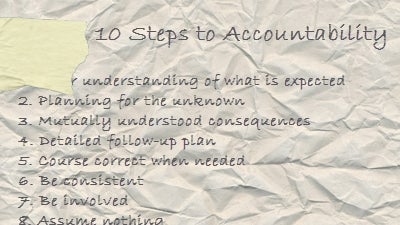
Early in my career, my boss gave me what he called “The 10 Commandments” to personal and team success. It was a laminated, front-and-back, wallet-size card with 10 statements on each side. One side was titled “10 Steps to Accountability” and the other side was “10 Steps to Right Person, Right Place, and Right Time.” Years later, and after a little repair work, I still have that card folded up inside my wallet—available for quick inspiration in a time of need.
Without fail, when struggles occur, I go to the card and, voila—there I find the source of the issue. It may be a simple step that was ignored, skipped, or forgotten. To help you and the people around you become better at what you do and to enjoy more success, follow these 10 Steps to Accountability:
1. Clear understanding of what is expected
When you or your employees are unsure of their role and what is expected, performance will suffer. Even if you’re self-employed, it’s always a good idea to level-set.
To help clarify expectations, ask yourself a few questions:
- Do I have a clear understanding of what is expected of me? What do I expect of myself?
- Do the people around me understand my role?
- Do they understand the relationship between my role and theirs?
- Do they have a clear understanding of their role and expectations?
2. Planning for the unknown
Even the most carefully planned project can run into trouble. Save yourself some grief by planning for the unknown: identify potential problems, determine the likelihood of their occurrence, take preemptive action to avoid them, and minimize those you can’t.
3. Mutually understood consequences
Consequences are the most important performance and behavioral motivators. Clearly understood consequences guide performance and behavioral choices. For example, as a self-employed business owner, if you don’t acquire new customers, you don’t generate new revenue, and you jeopardize the health of your business (negative). Positive consequences, on the other hand, will inspire action that you want to repeat consistently and turn into habits.
A mutually understood consequence also helps effectively manage employee performance—more on this topic later.
4. Detailed follow-up plan
Never end a meeting, strategy session, or coaching session without clear and actionable “next-steps.” Always schedule the next review. With each subsequent session, review execution timelines and goals that were developed and committed to—following-up directly with those responsible for performing specific tasks. Continue this process until the completion of the project—and then follow-up again!
5. Course correct when needed
Just because you put together a plan doesn’t mean you have to stick with it no matter what. You have to exercise wise judgment and know when to persevere and when to change course. If what you’re doing is clearly not working, you better move and move fast. Go back to the drawing board. Did you forget about one of the other “accountability” steps, or did something else happen?
6. Be consistent
To build trust and accountability, you must show consistency in your actions, performance, and leadership. For me, the most powerful example of this is raising children. For example, when I tell my daughter that she has “until the count of three” to correct her behavior (whatever that may be), I’m essentially giving her two chances to disobey. Whereas when she reaches for the hot stove, I tell her to stop and expect her to follow my command on the first try. If I were to give her commands the same way every time, I would alleviate confusion and set her up for success. So be consistent in your approach to work, people, and your communications—accountability will follow.
7. Be involved
Be inquisitive, ask questions, engage people in conversation, listen, and solicit feedback. Coach, mentor, and be available as much as possible. Never close your door unless you’re in a private meeting. It’s amazing the things you will learn, what you can improve, and how you (and others) will grow just by being more involved.
8. Assume nothing
While “assume nothing” is a good mantra to subscribe to, you might also want to remind yourself: “assume that you are assuming things without realizing you’re assuming them.” Don’t take anything for granted. Never overestimate the confidence customers, employees, and other stakeholders have in you and your actions. Conversely, never overestimate your confidence in your employees, operational systems, or suppliers. Communicate openly and regularly, challenge when appropriate, be consistent, and be involved.
9. Recognize performance
Promote a culture of candor. Be transparent, genuine, and honest. Put the proper rewards and recognition in place for great performance. And don’t always think that money is the greatest motivator. Verbal recognition in private or in public, a new office space, parking spot, or work schedule can be highly appreciated and motivating.
10. If success doesn’t come, go to right person, right place, and right time
If you’ve followed the first 9 steps and still haven’t found success, we’ll discuss what to do next in my next article: Right Person, Right Place, and Right Time.
Published: August 9, 2013
18978 Views
18978 Views










